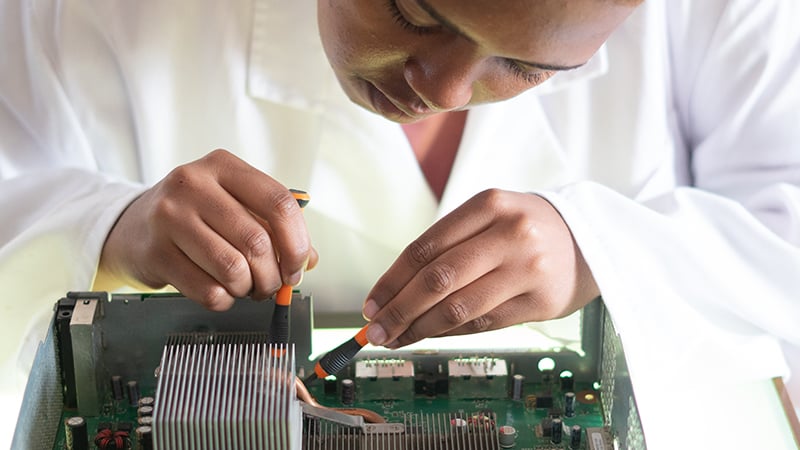This website uses cookies so that we can provide you with the best user experience possible. Cookie information is stored in your browser and performs functions such as recognising you when you return to our website and helping our team to understand which sections of the website you find most interesting and useful.
New product obsolescence research: costly repairs stop consumers fixing devices

Consumers in Belgium, France, Germany, Italy, Portugal, Spain and The Netherlands have been reporting their experiences of broken devices and appliances via an open online platform and surveys. TVs, smartphones and washing machines were amongst the products that consumers most frequently reported for breaking down too early TVs, smartphones and washing machines were amongst the worst offenders for breaking down earlier than consumers expected, and costs for getting things fixed was the main reason people did not get a repair.
How the PROMPT project is tackling e-waste and product obsolescence
The research is part of a wider multi-stakeholder EU Horizon 2020 project called ‘PROMPT’ (Premature Obsolescence Multi-stakeholder Product Testing). PROMPT’s aim is to extend product lifetimes and speed up the transition to a circular economy – one where waste is designed out and resources are continually repurposed. This will help with the urgent problem of e-waste. According the UN’s 2020 global e-waste monitor, the world throws away over 53.6 million metric tonnes of often highly toxic e-waste each year, with predictions that this rate could double by 2050 if we don’t act soon. This works out at around 7kg of e-waste per person each year, but that more than doubles in some countries with Europeans producing 16.2kg per person. Encouraging more durable design by manufacturers and improving access to repairs is critical for reducing this waste stream – but to develop a new system where consumers
regularly repair devices, we need a better understanding of their current experiences and attitudes.
Consumer expectations of electronic product lifetimes
Generally, consumers’ expectations of the useful lifetime of products depends on the type of product, so people will be more tolerant of a smart phone breaking after four years than, for example, a washing machine. However, we know from previous research that the concept of expected lifetimes and obsolescence is a complex one,
related to both the physical condition of the product and other psychological
or economic factors. Regardless of what is driving expectations and behaviour,
recent research from 2020 shows that many products are disposed of before they have reached the end of their functional life.
So what do consumers do and feel when one of their devices or appliances breaks down earlier than expected? And what can this tell us about how to design a better,
consumer-centered repair system? The new research insights from PROMPT
are based on data collected from 14,178 direct consumer reports of product
failures via a web tool developed by Euroconsumers and made available in
Belgium, Spain, Italy, Portugal, another web tool was used in France, while in
Germany and the Netherlands 5,649 responded to a survey. Mostly higher value
items were reported – reflecting people’s motivation to report (but also
perhaps a motivation to repair) expensive products that they expected to last
longer. Although the sample was not fully representative as participants
were reached via the consumer organisations’ networks, many useful insights
have emerged.
Products with the most reported early breakdowns
The biggest product categories across all markets for failing earlier than expected were:
- Smartphones: battery depletion accounted for 33 per cent of reported defects. Besides batteries, software issues and display performance problems were also commonly reported. These may not necessarily limit the usefulness of the device but can reduce its perceived value to the owner.
- Washing machines: between a quarter and half of consumers mentioned an issue with the electronic controller or the drum bearings – each of these parts is usually relatively expensive to replace.
- TVs: the screen, mainboard and power supply responsible for over two thirds of reported breakdowns. Again, these parts are relatively expensive compared to the price of the entire device.
- Dishwashers, printers and ‘smart’ connected vacuum cleaners: were also frequently mentioned, with reports of broken or ‘failed’ products coming around two to three years after purchase. The rise of connected products also means a new variety of things to go wrong, such as screens, batteries or software.
Consumer barriers to the right to repair
The data also showed that generally consumers are more likely to get repairs for large household appliances than small household appliances or consumer electronics. However, people only attempted to repair about a third of all reported products –
regardless of whether the products were still covered by a legal warranty.
Consumers in all countries said the cost of repair was the most important reason for not getting their broken product fixed. This was often related to the cost of repair
relative to the perceived residual value of the product. So, while it was rare for consumers to report that they didn’t repair a product just because they wanted an excuse to buy a new one, many did take the option of buying a new one as a replacement as it was more cost-effective.
Those who attempted a repair used a range of different options from self-repair to independent repair services, returning it to the manufacturer or returning it to the retailer. Approximately 20 per cent had a successful repair (although this depended on the product – up to a third of washing machines repaired successfully compared to
only one in eight of TVs). In six of the seven countries, consumers who turn directly to the manufacturer are more likely to succeed with the repair than those who return the product to the point of sale. This result is the same for products that broke down within two years after purchase, which is surprising since it falls within the legal guarantee.
Understanding consumers experience will help reduce product obsolescence
Even these early findings from a relatively narrow sample suggest that it’s not just devices that need fixing, but the whole consumer product repair system. Costs, access
to easy repair options and success rates all need to be addressed as well as better understanding of consumers’ rights whilst under warranty. Understanding consumer experiences with broken devices and barriers to engaging will help build a thriving, circular repair system which can help develop new industries and services, save consumers money and prevent environmental impacts.
The PROMPT project will be featured at Euroconsumers’ BeXt online awards event on 30th September 2021 where Euroconsumers’ Els Bruggeman will lead a panel on ‘Repairablity and Early Obsolescence’.
Participation is free but don’t forget to register here!
If you’d like to report a product that you think has failed to soon please visit
- Italy: https://www.altroconsumo.it/obsolescenza-programmata
- Belgium: https://www.test-achats.be/trop-vite-use
- Spain: https://www.ocu.org/barometro-de-obsolescencia-prematura
- Portugal: https://www.deco.proteste.pt/contra-obsolescencia-prematura
The PROMPT project has received funding from the European Union’s Horizon 2020 research and innovation programme under grant agreement No 820331. Find out more at: https://prompt-project.eu/



